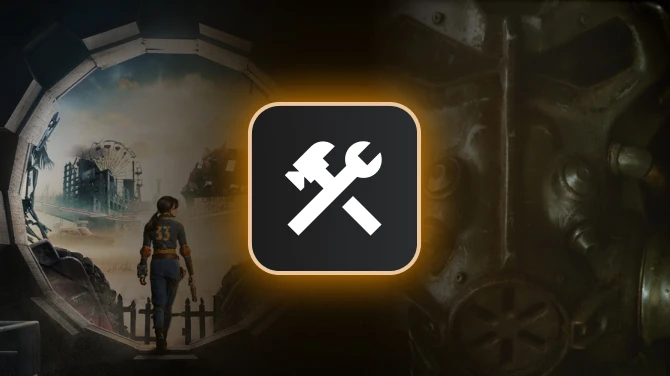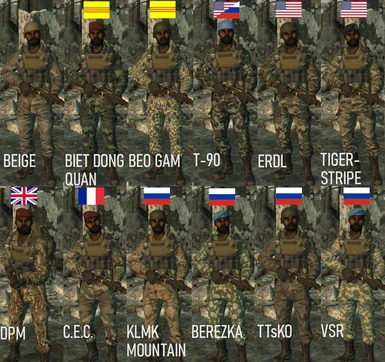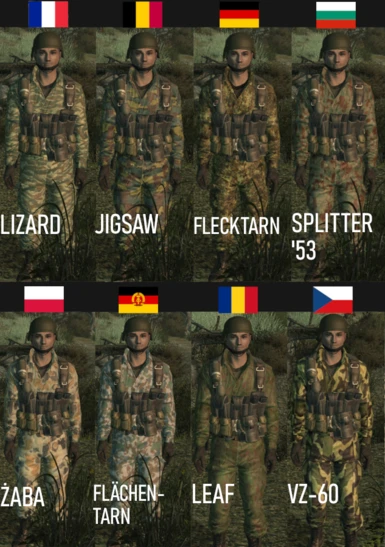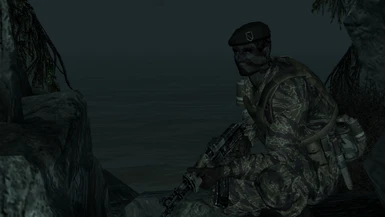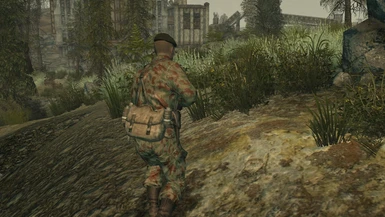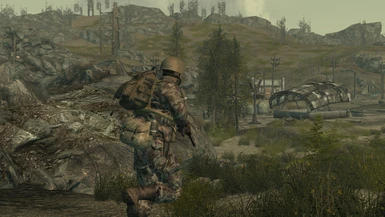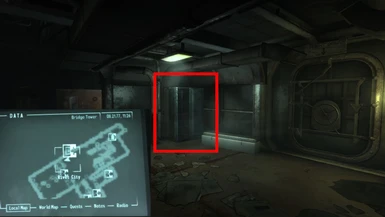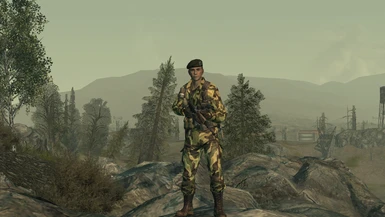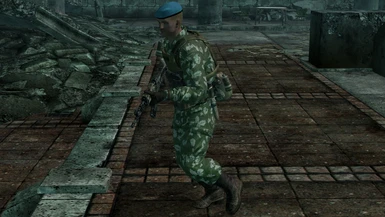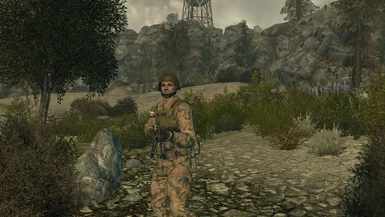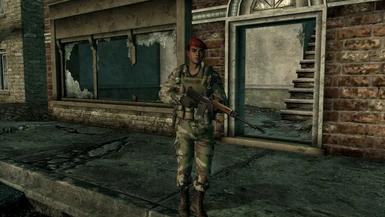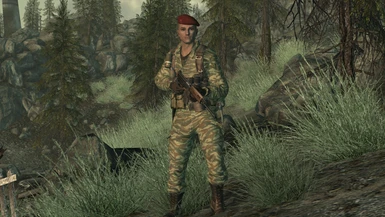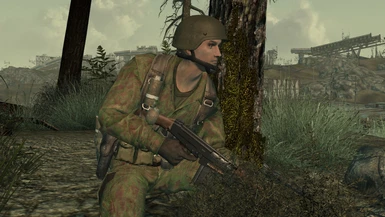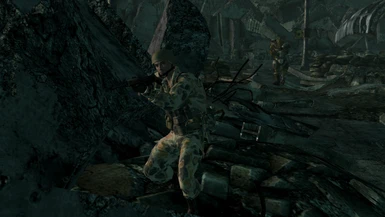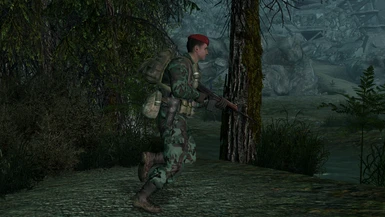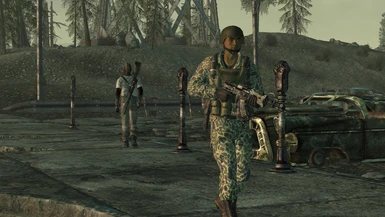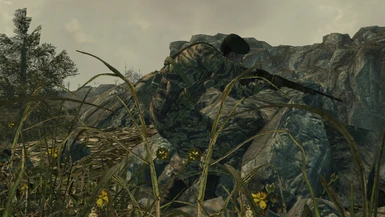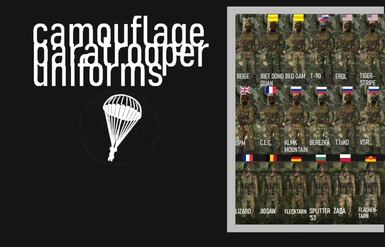About this mod
Mod containing several camouflaged uniforms in paratrooper style. 20 different outfits in total as well as headgear pieces.
- Permissions and credits
No requirements, and doesn't replace anything - standalone armor pieces only
Items are located at the Rivet City security tower, in a storage locker on the bottom floor. If you can't find the location, type "coc RCtower" to be teleported directly to the location of the container. Check screenshots as well
Stats are identical to combat armor for both body and headgear pieces, except headgear has a health value of 500 rather than 50.
-
Base items in V 1.0:
N/A
Beige - A simple coyote-tinted uniform. A more 'universal' type of concealment that will work somewhat well in most areas, but won't excel in any particular environment.
South Viet Nam
Biet Dong Quan(BDQ) - Camo developed about the same time as ERDL, it was issued as early as 1964. Produced locally in South Vietnam and used by ARVN ranger and airborne units, it was intended for use in thick jungle and vegetation that these troops would usually find themselves in.
Beo Gam(Leopard) - Pattern used frequently by Montagnard CIDG and less commonly by various ranger units. it was originally derived from the duckhunter pattern used by MACV SOG. Works in light woodland, prairie, grassland, and some urban environments.
United States
ERDL woodland - Camo which began development in the late 40s from samples of various camos from southeast Asia. Highland variant, used by U.S. marines and some army units in Vietnam. ERDL in both lowland and highland variant were also issued to ranger, airborne and marine units of the ARVN.
ERDL arid - Experimental variant which never saw use by the US military. Intended to work in arid and fall season environments, mirroring the retired brown variant Mitchell pattern.
Tiger stripe - pattern originally developed in south Vietnam, several dozens of variations were made. it was favored by U.S. special forces servicemen who purchased the garments privately in the local markets or on leave in Thailand. this specific variant works in woodland and against dry underbrush
T-90 - Experimental camouflage produced in Russia and Eastern Europe, originally based on U.S. M-81 woodland pattern. Never used by any militaries and sold commercially. Intended to work in tundra and forest.
United Kingdom
DPM - Disruptive Pattern Material is a term for a range of variations of a brushstroke-type pattern in woodland and desert. This variant is in traditional woodland colorway.
France
C.E.C. - Camouflage Europe Centrale was the standard French camouflage for several years and is visually similar to ERDL though with larger prints. This pattern has been seen in a few different variations in shading but is mostly functional for woodland and grassland environments.
Russia
Berezka - "Birch" was first issued in 1968 and left a legacy for years to come, as it is still in use to this day by various special force units in eastern Europe and Russia. intended to be used in summer grassland, woodland and forest environments
KLMK Mountain - Designed in 1992 and issued in limited quantity to the Brigades of Special Designation of the MVD. As the name suggests it is intended for use in mountainous environments.
TTsKO - Camo from 1988 which saw much use in Chechnya and Georgia. This variant is seemingly intended to work in fall-season environments against dead foliage.
VSR - Named after the Russian Armed Forces or called 'dubok' by others, this camo saw extensive use in Chechnya and Georgia. Throughout the 2000s this camouflage has been phased out but still sees some use in rear eschelon units. Intended to work in grassland and mountainous woodland environments.
Accessory
Backpack - 60 lbs carry capacity
PASGT Helmet Olive
PASGT Helmet Coyote
PASGT UN Peacekeeper - for shits and giggles
MACV SOG beret
VDV beret
Red French-style beret
-
European sets update V 1.2
France
Lizard - Finalized in a few variants, this camo was standardized for use across the French military after being developed throughout the 1950s using WW2 British brushstroke camo as a base of reference. This type of camo was also the source of the shapes of the 'tiger stripe' camouflages produced in southeast Asia during the Indochina war and Vietnam war periods.
Belgium
Jigsaw - Introduced in 1956 and still used contemporarily, this camo was originally restricted for elite units but eventually became standard issue for the Belgian army. This camouflage has been well documented in many African conflicts also, being used by both local militant groups and foreign mercenaries.
Germany
Flecktarn - Top performer of the Truppenversuch 76 trials, this pattern became adopted for standard issue in Germany and continues to see use. Has been produced in tropical and desert climate variants in addition to the standard woodland, and has been copied countless times by commercial retailers due to its popularity.
Bulgaria
Splittermuster '53 - A camouflage created shortly after WW2, it was based on the German splittermuster pattern. While being fundamentally similar to the source, it utilized shapes and colors unique to its own design. It was designed for and issued to airborne units.
Poland
Żaba - This pattern began first as a print for parachute shrouds used by Polish airborne units, who would cut the fabric after landing and improvise helmet covers or even have entire uniforms custom-tailored. The pattern was never officially printed into legitimate uniforms, but the tailored ones still see use into contemporary service.
East Germany
Flächentarn - Also called 'blumentarn'. Standard issue for all units of the East German army, issued between 1956 and 1967 until it was replaced by the strichmuster 'rain' pattern in 1968. Its design is very much of Russian origin, which contrasts sharply to the splinter-type patterns that west Germany was still using at the time, some of which were even leftover stock from the Third Reich.
Romania
1960 Inverse Leaf - A camouflage produced locally which was based on the 1941 Soviet leaf camo. The Soviet leaf uniform and the Romanian variant were issued in 1960 to recon and elite light infantry units, and used until the 1990s. This is another pattern that has been seen used in conflicts on the African continent.
Czechoslovakia
VZ-60 Mlok - This pattern, known as 'salamander', was issued in 1960 exclusively for the 22nd Airborne Brigade. In addition to its use locally in the Czech Repulic, it has also been serviced in Yemen and Palestine.
Accessory
Jump vest no longer part of base uniform, wearable as separate item
___
mod created with nifskope, blender, GIMP, and the GECK. credits to dragbody for resources, custom meshes and textures created by me.







